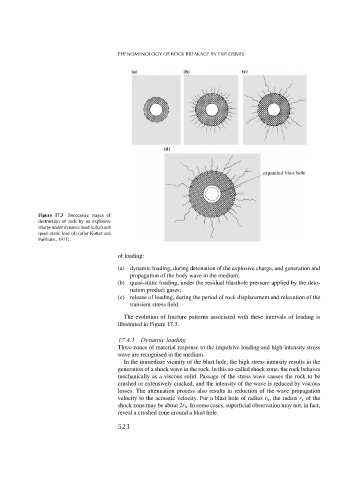Page 541 - Rock Mechanics For Underground Mining
P. 541
PHENOMENOLOGY OF ROCK BREAKAGE BY EXPLOSIVES
Figure 17.3 Successive stages of
destruction of rock by an explosive
charge under dynamic load (a,b,c) and
quasi-static load (d) (after Kutter and
Fairhurst, 1971).
of loading:
(a) dynamic loading, during detonation of the explosive charge, and generation and
propagation of the body wave in the medium;
(b) quasi-static loading, under the residual blasthole pressure applied by the deto-
nation product gases;
(c) release of loading, during the period of rock displacement and relaxation of the
transient stress field.
The evolution of fracture patterns associated with these intervals of loading is
illustrated in Figure 17.3.
17.4.1 Dynamic loading
Three zones of material response to the impulsive loading and high-intensity stress
wave are recognised in the medium.
In the immediate vicinity of the blast hole, the high stress intensity results in the
generation of a shock wave in the rock. In this so-called shock zone, the rock behaves
mechanically as a viscous solid. Passage of the stress wave causes the rock to be
crushed or extensively cracked, and the intensity of the wave is reduced by viscous
losses. The attenuation process also results in reduction of the wave propagation
velocity to the acoustic velocity. For a blast hole of radius r h , the radius r s of the
shock zone may be about 2r h . In some cases, superficial observation may not, in fact,
reveal a crushed zone around a blast hole.
523

